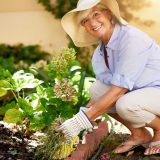

It can seem overwhelming at first when you’re new to gardening. Take a breath and get ready to start something that will lead to a more calm and relaxed you. It’s healthier for you and your family because you’ll have fresh, better quality foods. You’ll also be saving money. Whatever you end up planting, it will make your yard come alive with beautiful colors and foliage.
Here are 6 steps to take when you’re starting and planning your new garden:
- What do you want to plant? Flowers, fruits, vegetables, herbs…? Think about what you like to eat, what herbs you use or what colors of flowers you want to spruce up your yard with. They all have different care directions, so be sure to take note of this for each one you’re going to plant. This will help you narrow down the site of where your garden will be.
- Find a good location for your garden. This is the key to keeping a healthy, growing garden. Make sure the spot you pick gets enough sunlight and that it is big enough to accommodate what you’re planting. For vegetables you need a decent sized space, at least 4-by-4 feet. Flowers can be grown almost anywhere. There are a few different types of gardens: traditional, raised-bed or container gardens. Research these types and decide which are best for where you live and what you’re growing.
- Fertile soil is the basis for your garden. Start by tilling (turning over) the soil to see what you’ve got to work with and make sure to remove any rocks you find. Some people make their own soil, but this may not be a good idea for those just starting out. You can ask around and research how to make your own if you want to. If you’re buying from the store it will ensure that the soil has the right balance of its materials. Compost is also a great way to keep your garden healthy and happy. It’s very easy to start your own compost heap.
- A really fun part of gardening is designing it. You can pick a theme or color scheme to make it more cohesive. You can add stone around the perimeter. Don’t over think it because you will most likely have to change it depending on how your plants are growing. Have fun with it!
- Make sure you have the right tools to start and maintain your garden. Don’t go crazy buying every tool you see. Get the basics: shears, rake, kneepads or bench, gloves, shovels and, of course, a watering can or hose. Some tools are expensive, but they are the ones that will work better, last longer and make working much easier. And, although not technically a tool, be sure to have sunscreen and a hat on hand.
- Maintaining your garden is very important. You will learn about your plants and what they need to stay healthy as they grow. Pay attention to how they respond to certain factors of the environment. Maintenance is where the most relaxation takes place. This is your space and your creation. Forget about what’s going on around you and find solace in your plants that you brought to life. Take pride in your garden!




